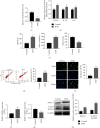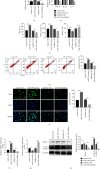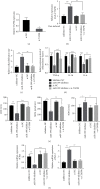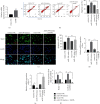MiR-199 Aggravates Doxorubicin-Induced Cardiotoxicity by Targeting TAF9b
- PMID: 35873641
- PMCID: PMC9307339
- DOI: 10.1155/2022/4364779
MiR-199 Aggravates Doxorubicin-Induced Cardiotoxicity by Targeting TAF9b
Retraction in
-
Retracted: MiR-199 Aggravates Doxorubicin-Induced Cardiotoxicity by Targeting TAF9b.Evid Based Complement Alternat Med. 2023 Dec 13;2023:9890380. doi: 10.1155/2023/9890380. eCollection 2023. Evid Based Complement Alternat Med. 2023. PMID: 38125152 Free PMC article.
Abstract
The clinical application of doxorubicin (DOX) is limited because of its cardiotoxicity. However, the pathogenic mechanism of DOX and the role of miRNA in DOX-induced cardiotoxicity remain to be further studied. This study aimed to investigate the role of miR-199 in DOX-mediated cardiotoxicity. A mouse model of myocardial cell injury induced by DOX was established. Quantitative real-time polymerase chain reaction (qRT-PCR) was used to detect the expression changes of miR-199 and TATA-binding protein associated factor 9B (TAF9b) in DOX-induced cardiac injury. Cell apoptosis was detected by TUNEL staining and flow cytometry. The expression levels of apoptosis-related proteins, namely, Bax and Bcl-2, were detected by qPCR. The expression of Beclin-1 and LC3b was detected by western blotting. The binding effect of miR-199 with TAF9b was verified by dual-luciferase reporter gene assay. In this study, overexpression of miR-199 could promote cardiotoxicity. Inhibition of miR-199 could alleviate DOX-mediated myocardial injury. Further studies showed that miR-199 targeted TAF9b. Moreover, miR-199 promoted apoptosis of myocardial cells and aggravated autophagy. Furthermore, we demonstrated that TAF9B knockdown reversed the myocardial protective effect of miR-199 inhibitors. Therefore, miR-199 promoted DOX-mediated cardiotoxicity by targeting TAF9b, thereby aggravating apoptosis and regulating autophagy.
Copyright © 2022 Yangsheng Yu et al.
Conflict of interest statement
The authors declare that they have no conflicts of interest.
Figures






Similar articles
-
miR-146a attenuates apoptosis and modulates autophagy by targeting TAF9b/P53 pathway in doxorubicin-induced cardiotoxicity.Cell Death Dis. 2019 Sep 11;10(9):668. doi: 10.1038/s41419-019-1901-x. Cell Death Dis. 2019. PMID: 31511497 Free PMC article.
-
MicroRNA-194-5p Attenuates Doxorubicin-Induced Cardiomyocyte Apoptosis and Endoplasmic Reticulum Stress by Targeting P21-Activated Kinase 2.Front Cardiovasc Med. 2022 Mar 7;9:815916. doi: 10.3389/fcvm.2022.815916. eCollection 2022. Front Cardiovasc Med. 2022. PMID: 35321102 Free PMC article.
-
MicroRNA-29b Regulates the Mitochondria-Dependent Apoptotic Pathway by Targeting Bax in Doxorubicin Cardiotoxicity.Cell Physiol Biochem. 2018;48(2):692-704. doi: 10.1159/000491896. Epub 2018 Jul 19. Cell Physiol Biochem. 2018. PMID: 30025410
-
Downregulation of TAF9B by miR-7-5p Inhibits the Progression of Osteosarcoma.Onco Targets Ther. 2021 Apr 30;14:2917-2927. doi: 10.2147/OTT.S264786. eCollection 2021. Onco Targets Ther. 2021. PMID: 33958878 Free PMC article.
-
MicroRNA miR-215-5p Regulates Doxorubicin-induced Cardiomyocyte Injury by Targeting ZEB2.J Cardiovasc Pharmacol. 2021 Oct 1;78(4):622-629. doi: 10.1097/FJC.0000000000001110. J Cardiovasc Pharmacol. 2021. PMID: 34282068
Cited by
-
The beneficial role of exercise in preventing doxorubicin-induced cardiotoxicity.Front Physiol. 2023 Mar 9;14:1133423. doi: 10.3389/fphys.2023.1133423. eCollection 2023. Front Physiol. 2023. PMID: 36969584 Free PMC article. Review.
-
Retracted: MiR-199 Aggravates Doxorubicin-Induced Cardiotoxicity by Targeting TAF9b.Evid Based Complement Alternat Med. 2023 Dec 13;2023:9890380. doi: 10.1155/2023/9890380. eCollection 2023. Evid Based Complement Alternat Med. 2023. PMID: 38125152 Free PMC article.
-
MicroRNA in the Diagnosis and Treatment of Doxorubicin-Induced Cardiotoxicity.Biomolecules. 2023 Mar 20;13(3):568. doi: 10.3390/biom13030568. Biomolecules. 2023. PMID: 36979503 Free PMC article. Review.
-
Mechanisms of ferroptotic and non-ferroptotic organ toxicity of chemotherapy: protective and therapeutic effects of ginger, 6-gingerol and zingerone in preclinical studies.Naunyn Schmiedebergs Arch Pharmacol. 2025 May;398(5):4747-4778. doi: 10.1007/s00210-024-03623-5. Epub 2024 Dec 5. Naunyn Schmiedebergs Arch Pharmacol. 2025. PMID: 39636404 Free PMC article. Review.
-
Exosomes Derived from hucMSCs Primed with IFN-γ Suppress the NF-κB Signal Pathway in LPS-Induced ALI by Modulating the miR-199b-5p/AFTPH Axis.Cell Biochem Biophys. 2024 Jun;82(2):647-658. doi: 10.1007/s12013-023-01208-2. Epub 2024 Jan 13. Cell Biochem Biophys. 2024. PMID: 38216808
References
-
- Schilt Y., Berman T., Wei X., Barenholz Y., Raviv U. Using solution X-ray scattering to determine the high-resolution structure and morphology of PEGylated liposomal doxorubicin nanodrugs. Biochimica et Biophysica Acta (BBA)—General Subjects . 2016;1860 doi: 10.1016/j.bbagen.2015.09.012. - DOI - PubMed
Publication types
LinkOut - more resources
Full Text Sources
Research Materials

